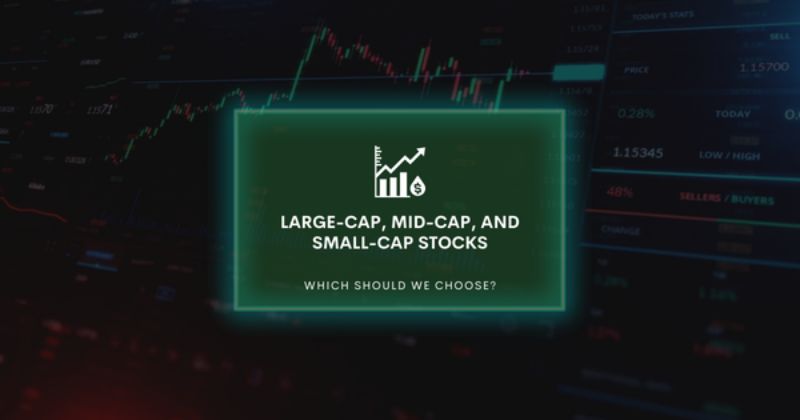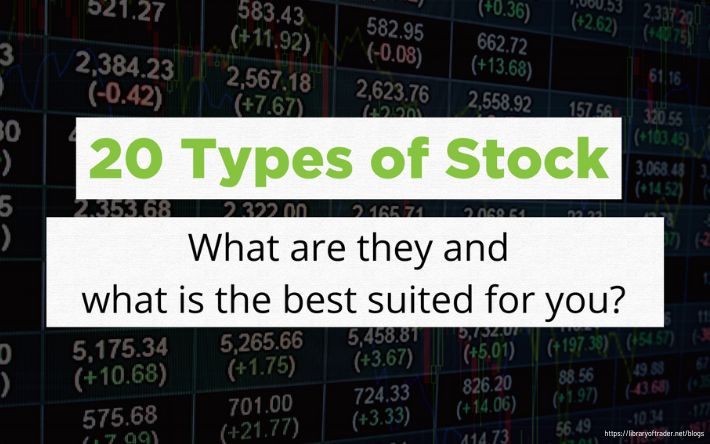What are different types of stocks in the stock market? What are the pros and cons of each type? These questions might be among the most popular among beginner stock traders. It is an ocean of information that can be overwhelming to novice traders.
This blog can help you sort out the essential information. We walk you through 20 types of stocks with a brief explanation of their advantages and potential risks. Please scroll down for more detailed information!

Common Stock
Common stock indicates ownership in a corporation. It means that those holding a common stock can elect the board of directors, agree, and disagree on corporate policies.
Among equity ownership forms, it yields higher rates of return in the long-term run. Yet, common shareholders only access a company’s assets after bondholders, preferred shareholders, and other debt holders get full payments.
Common stock refers to a residual gain to a company’s current and future profits. It implies that such shareholders own a company together with the founders.
You should not get it wrong, however, that these people can claim ownership of chairs, desks, or computers. In other words, they do not own a legal entity that belongs to the corporation. To be clear, what common shareholders own is the residual claim.
Are you confused about common stock with preferred stock?
Common type, as its name suggests, is a widely used type of share that a company issues and you will likely find in a stock trade on an exchange. It comes hand in hand with voting rights but comes last in the preference order of being repaid in case of a company’s bankruptcy.
Meanwhile, preferred shares are among the first to gain returns on investments in a bankrupt company. Yet, these holders do not have voting rights and dividend payments regularly like common shareholders.
Preferred Stock
Preferred stock indicates ownership or equity in a firm but with a higher claim to dividends or asset distribution than common shares. Also, those who own this type of stock will be on the top list of getting repayments when a company goes bankrupt.
The dividends of preferred shares are fixed or adjusted based on a benchmark interest rate such as the London InterBank Offered Rate (LIBOR). The details of the percentage are in the issuing description.
The adjustability of share rates involves specific factors that impact the dividend yield. Besides, common stock dividends or the company’s profits influence additional dividends on participating shares. At the end of the day, a company’s BODs determine the rate of dividends.
Despite having higher dividend yields and coming ahead in the preference order, preferred stockholders do not have voting rights as common shareholders.
Preferred shares are a hybrid between bonds and common stocks. In other words, it has features in common with debt to pay fixed dividends and equity.
So, this type of stock is suitable for those who look for stability in the potential growth of cash flows without getting involved in the management or a corporation.
Large-Cap Stocks

Large-cap stocks indicate the stock of publicly traded companies having a value of more than $10 billion.
With such a huge amount, people also call them big-cap stocks, the stalwarts, and blue chips.
For instance, Walt Disney (NYSE: DIS), Coca-Cola (NYSE: KO), General Motors (NYSR: GM), etc. are giants in their industries. The largest big-cap companies are Amazon and JP Morgan with more than $200 billion in value each.
Smaller companies with fast growth can be exciting to many investors. Yet, large-cap stocks can offer chances to earn high profits if investors spend time on research. They can enjoy stable growth as these mammoth companies are not likely to be tumultuous amidst the chaotic market.
So, people can take large-cap companies in their portfolios to decrease risks while investing in smaller stocks. As you know, portfolio diversification is among the most crucial factors to maintain the consistency of profitability.
These stocks are a safer choice thanks to reliable profit streams. It can be a resort during a bear market to undertake lower potential losses. Taking the Covid-19 pandemic and its effects on the international economy, large caps outperform smaller peers due to less volatility.
The disadvantage of this stock type is moderate profit growth prospects. So, it might be less exciting for those who love to ride on the roller-coaster of emotions like investing in fast-growing companies.
Mid-Cap Stocks
Mid-cap stocks are shares of a company having a market value between $2 billion and $10 billion.
They might have had a growing business model and foothold in their industries. Rapid growth will be among the high possibilities in these companies’ future. As their target is to become big-cap ones.
Being in a middle position, these stocks have not made it to big-cap status but have developed business track records higher than small peers.
So, risk exposure and profitability are all at the middle level. It cannot be as exciting as small-cap stocks, yet it entails faster growth rates than large-cap stocks. Two primary benchmarks for mid-cap stocks are
- S&P MidCap 400 Index keeps track of the 400 mid-sized U.S. companies with values ranging from $2 billion to $8 billion.
- Russell Midcap Index manages nearly twice the number of companies as the S&P MidCap index, which goes beyond 800.
People tend to see the fast growth of small caps or the stability of large caps. So, it is easy to overlook mid-cap stocks. Yet, if you spend time digging for information about the performance of mid-caps, you might find hidden gems.
Small-Cap Stocks
A company whose total market value or market capitalization ranges from $300 million to $2 billion has small-cap stocks.
The common feature of these stocks is a fast growth, which can lead them to become mid-cap or large-cap stocks.
Due to small capitalization, many people usually take startups or brand-new companies as small-cap ones. Yet, it is a misconception. In fact, many well-established businesses with strong track records still have small capitalization.
So, should we choose to invest in small-cap companies?
The answer heavily depends on your financial goals, risk tolerance, and your preferred style. If you would like to have a thrilling journey in which large profits with fast growth come along with higher risk, investing in small-cap stocks can be a great choice.
Otherwise, if you want to have a percentage of stability, mid-caps and large-cap stocks should be in your consideration.
The keynotes that determine your investing success include data-driven strategies. Any investment decision should be the outcome of a thorough analysis rather than following your instincts.
Domestic Stock
Domestic stocks refer to the shares of American companies on a wide range of stock exchanges. You can find them on large American stock exchanges, such as the NASDAQ, the New York Stock Exchange, and the American Stock Exchange.
Some common types of domestic stocks include common stock, preferred stock, and convertible preferred stock.
We have already walked you through the common stock and preferred stock above. So, we will share a brief description of convertible preferred stock.
It works like a preferred stock as it pays dividends and offers priority in the preference order in case of a company’s bankruptcy. Yet, it can switch from preferred stock to common stock in certain publicly disclosed conditions.
International Stocks
If the shares belong to a company outside your home country, they are international stocks. Investing in such shares is one of the effective ways to diversify your portfolio.
For example, if you invest in domestic stocks, your investments will be under the tremendous influence of your nation’s economy. When things go well, you gain profits. Otherwise, you might suffer from expensive pitfalls.
Yet, if there are international stocks in your portfolio, the gains from international companies can cover the potential losses caused by the downfall of domestic companies.
No perfect scenarios have happy endings. There are still possibilities of losses when investing in these stocks.
First is currency risk. If the U.S. dollar becomes weak, investors can hedge against the currency move. However, if the U.S. dollar gets stronger, the performance of these stocks can get worse.
Other risks come from geopolitics. The policymakers on economics can change or limit the liquidity of stocks across borders. It leaves investing in these stocks vulnerable to geopolitical conditions.
Growth Stocks
Growth stocks are the shares in a company with the expectation of significant growth above the average level. They usually appear in any sector or industry for trading at a high price-to-earnings (P/E) ratio.
Investors will not gain dividends when investing in these stocks as their issuers use any earnings for reinvestments to speed up growth in the short period. So, what will they receive? They anticipate earning money through capital gains when selling shares in the future.
This model entails obvious risks as investors do not receive regular gains in the form of dividends while the future holds unpredictability. They can step up to become a rich guy or empty their pockets.
There are some features that you can use to determine growth stocks or growth companies. They focus on exclusive product lines with patents or technology that allow them to be ahead of their peers in the industry.
To keep up with fast growth, abundant reinvestments are crucial to constantly develop superior technologies and patents. As a result, they can be in the stage of consistency.
Value Stocks

Value stocks point at the shares that have a lower trading price than their fundamentals, including dividends, earnings, sales, etc. It means you pay low but gain higher, which makes it a bargain to many value investors.
These stocks are in contrast to growth stocks as they guarantee gains at a certain percentage. As the price of value stocks is lower than what a company can bring back to its investors. In other words, value investors earn profits from inefficiencies in the market.
How can we describe value stocks?
They have a high dividend yield, a low price-to-book ratio (P/B ratio), and a low price-to-earnings ratio (P/E ratio). Also, you can use the ‘Dogs of the Dow’ investing strategy to purchase the 10 highest dividend-yielding stocks on the Dow Jones. Then, you can adjust the portfolio annually.
IPO Stocks
IPO stocks are the shares that go into initial public offerings. In short, they turn from private shares into the public in a new stock issuance for the first time. As a result, this type enables a company to raise equity capital from public investors.
It is an important time for private investors in such a shift. They can fully gain from their investment with a share premium. Public investors can get involved in the offering.
As you can see going public is a big step for any company as it opens opportunities to raise a lot of money. It means that an IPO company has a greater possibility to grow and expand in the future.
Transparency and share listing credibility are two obvious outcomes after a company goes public. Consequently, it can gain more advantages to seek borrowed funds.
After reaching the stage of maturity, a company will go through SEC regulations for the benefits and obligations to public shareholders. The process of advertising its interest in the IPO will begin.
Usually, this stage takes place when a company has got a private valuation of around $1 billion. People call it a unicorn status.
Dividend Stocks
Dividend stocks generate regular distributions to their shareholders, usually in the form of cash or additional stock. The companies with these stocks are usually well-developed and have strong fundamentals with stable earnings.
It sounds great, does it? We do not deny that it is a profitable stock type, yet dividend stocks can be cut to preserve cash amidst difficult economic times. It emphasizes the potential risks that investors might take when investing in dividend stocks.
Consequently, it will be a great help when gauging the sustainability of a company’s dividend payments. The powerful metric here is the dividend payout ratio (DPR) which is the result of dividing net income by total dividends.
This measure implies how much dividends investors will gain in the company’s net income versus how much the company retains for reinvestments.
If DPR goes beyond 100% or stays negative, it points out that the company may not generate enough to pay investors. So, the implication is that there is a high possibility of dividend stocks being cut in tough situations.
Defensive Stocks
Defensive stocks go along with consistent dividends and stable earnings no matter what the state of the overall stock market is. Due to a constant demand for their products, these stocks can maintain stability in many phases of the business cycle.
Defensive stocks and defense stocks: Are they the same?
The names can bring about confusion, yet they are different types. Defensive stocks have the attachment of consistency and stability while defense stocks indicate the shares of companies in the field of manufacturing weapons, ammunition, and fighter jets.
Conservative investors prefer defensive stocks due to their stable rate of growth. Meanwhile, if investors love to be on the roller-coaster with high-risk and high-return stocks, this type might not be their cup of tea.
However, the blending between stability and high risks can be good for your portfolio. Throughout a weakening economy or periods of high volatility, defensive stocks can save you from huge losses. In other words, it can help you create a healthy balance in your investments and hedge against risks in unfavorable conditions.
Non-Dividend Stocks
No complicated definition or explanation! Non-dividend stocks are the shares of a company with no dividends for its investors. You can take growth stocks in this category as well as growth investors do not expect to earn regular dividends.
The key points in non-dividend stocks are their potential growth and the belief of the investors. Although they do not receive dividends regularly, they anticipate huge amounts of earnings through long-term investing.
Warren Buffett is a salient representative in this category. The small but regular income is not his pick but the fruit after a long-term investing period.
Is it risky?
Obviously, it entails risks in investments in non-dividend stocks. Yet, the question should be whether it is worth it or not. The results from technical analysis and fundamental analysis are powerful tools to build a big picture of its intrinsic values and potential growth.
What these investors see is not what will happen to the stocks in the next days or next month but in years which can be decades. So, non-dividend stocks are usually quality stocks!
Income Stocks
Once investing in income stocks, investors can gain regular dividends with increasing values. These shares typically come along with high yields and lower levels of volatility. You can find income stocks in real estate, energy sectors, utilities, natural resources, and financial organizations.
Due to limited future growth options, this stock type requires a lower level of ongoing capital investment. Investors can get any excess cash flow from profits every month or quarter.
Thanks to stable growth and less volatility, income stocks are the target of many conservative investors. Yet, it is way less exciting than investing in growth stocks.
Again, choosing a suitable stock type for your investment needs careful consideration of your financial goals, and risk tolerance. The creation of a healthy balance among stock types can also help your portfolio maintain optimal risk/reward ratios. It can save you from big losses in the stock market crash.
Cyclical Stocks
The prices of cyclical stocks are under the influence of macroeconomic or systematic changes in the overall economy. In other words, these shares reflect the cycles of an economy through expansion, peak, recession, and recovery through their prices.
It is easy to find cyclical stocks in companies selling consumer discretionary items that react to a booming period of economy and recession. Specifically, the companies with cyclical stocks can be automotive manufacturers, airlines, furniture retailers, clothing stores, hotels, etc.
As long as you keep track of economic statuses, you can easily forecast the prices of these cyclical stocks. Thus, it might give you some space for preparation and strategy development to earn high profits and undertake low risks.
Non-Cyclical Stocks
Unlike cyclical stocks, non-cyclical stocks do not change their prices due to the downfall or rise of the economy. In simple words, these stocks have a strong immunity system to economic instability.
Utility and energy companies usually own non-cyclical stocks as the demand for the products such as gas, gasoline, water, food, etc. never disappears no matter how bad the economy turns out to be.
The stability of this stock type makes it close with slow growth while cyclical stocks can help investors burst into tears of happiness in the rising economic status.
Yet, another scenario is that you can burst into tears due to big losses in the economic downfall if you do not react to changes timely. Meanwhile, non-cyclical stocks can still outperform even when economic growth slows.
Safe Stocks
Safe stocks have the attachment of stability and low volatility. This type implies that you can undertake risks but at as low as possible level.
The companies with safe stocks usually have strong fundamentals, transparent financial records, and stable growth rates across different economic phases.
According to Fool Motley, Berkshire Hathaway, Walt Disney Company, Vanguard High-Dividend Yield ETF, Procter & Gamble, etc. are the salient picks with a higher percentage of winning.
ESG Stocks
ESG stocks are the shares of a company for Environmental, Social, and Governance. So, when investing in these stocks, you can contribute to the development of a better world. The loss of biodiversity can worsen corporate profits, which sounds like big words. Yet, taking a full picture, everything gets connected.
Thus, ESG stocks can help you support activists and ESG companies to better this world. At the same time, it can create a favorable space for long-term growth with stability and balance.
Blue Chip Stocks
Blue chip stocks belong to large companies with great reputations and a long track record of successful operations. You can see these stocks as the blue ticks for the official accounts of celebrities!
When investing in these stocks, you can get high profitability due to their time-tested operating system. The blue chip companies usually have a market capitalization in the billions of dollars. Obviously, they are usually the leaders or among the top three firms in the industry.
There is no doubt that this stock type is a popular choice among many investors. You can consider blue chip stocks as safe choices, especially amidst the downfalls of the market.
Penny Stocks
Penny stocks are the shares of a small company at the price of less than $5/share. These stocks might imply that their companies have a lack of liquidity or ready buyers. Also, it has little information in public. Thus, investing in penny stocks entails high risks.
In the Nutshell
How many types of stocks are there? This question can help you find out types of stock market trades as every stock type has specific characteristics that fit certain approaches.
Also, the information can ease the process in which you choose a suitable category to invest in balancing risk tolerance and financial goals.
This article can help you better understand the stock market and stock trades. As a result, you can diversify your portfolio with profitable items.
Becoming a profitable stock trader takes time and effort to learn the market and stock types to develop strategies. It does not depend on a fluke like gambling.


